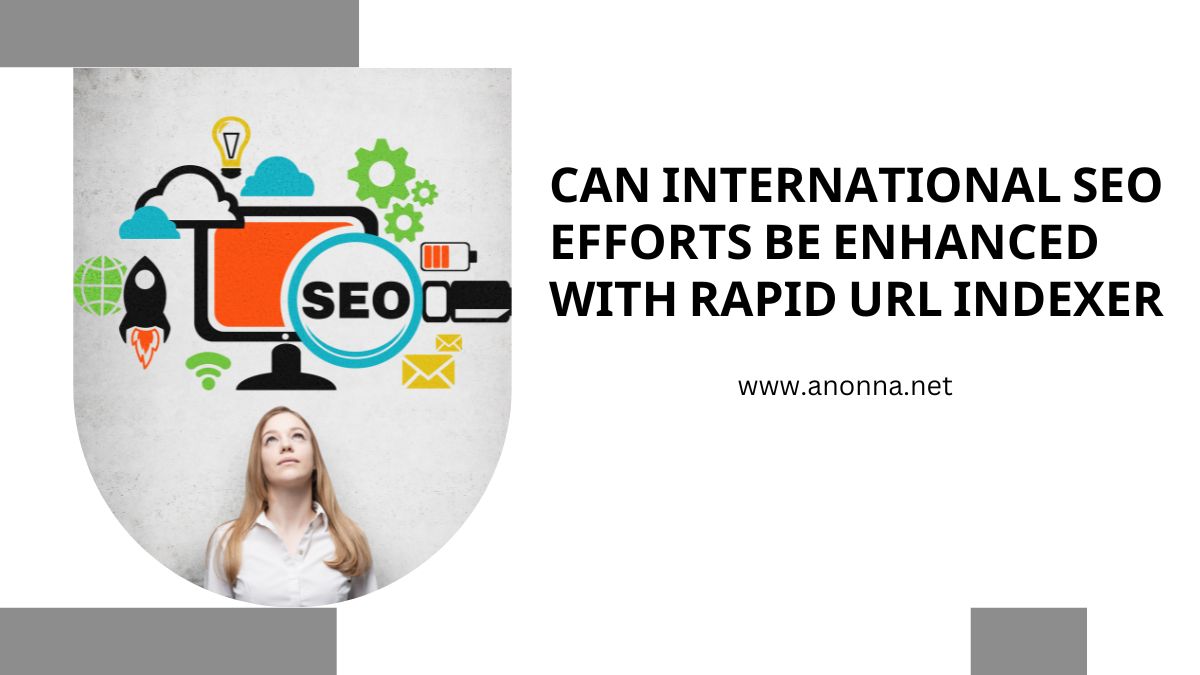
Can International SEO Efforts Be Enhanced with Rapid URL Indexer? A Guide to Faster Global Rankings
How Important is Speed of Indexing in International SEO
With businesses being conducted across borders in the global digital economy, International SEO is one-fits-all to reach users across geographies. When opting to target international markets, you should ensure that pages of your website get indexed early in the engines for visibility. If your content isn’t indexed quickly, it won’t show up in search results, costing you traffic, leads, and revenue in the process.
Unfortunately, indexing is not equal across search engines or locations. If you are running a business with new country-specific pages, multilingual versions, or hreflang tags, slow indexing is your nightmare. Indexing delays—as in how quickly search engines can identify and rank new content—can affect international visibility negatively.
What is Rapid URL Indexer and how does it work?
This means that you can use Rapid URL Indexer to speed up the index process and get your web pages into search results a lot faster. It bypasses the delay waiting for Google’s own bots to naturally crawl your content by submitting URLs to search engines directly.
Now let’s see some important advantages of Rapid URL Indexer:
✅ International pages are indexed more quickly when new pages added or changes made
✅ Improved visibility for content in multiple languages and regions
✅ Higher rankings by getting your content seen by search engines faster
✅ Increased speed of access of the content to the international audience that boosted traffic
As search engines top fresher and frequently updated content over less active content, employing techniques such as Rapid URL Indexer can provide a competitive advantage in international SEO.
What This Article Covers
In this article, you will learn how Rapid URL Indexer can enhance International SEO efforts and how you can use this:
📌 The indexation issues of businesses entering new international markets
📌 How does Rapid URL Indexer work and why it is fast in indexing
📌 Faster indexing introduces a lot of benefits to international markets
📌 Tips on how to use Rapid URL Indexer the right way
📌 How it can impact SEO + common mistakes to avoid
So, by following this guide to the end, you will know exactly how to speed up the indexing process and drive in your international search engine results effectively. 🚀 Let’s dive in!
Learning About Challenges in International SEO & Indexing
There is more to going global than simply taking the existing content and translating it. It requires a properly planned International SEO strategy to make sure that Search Engines understand, rank and show correct content to users from various regions. One aspect of this process is fast and efficient indexing, which is how fast search engines like Google discover new or updated web pages.
In this chapter of section, we’re going to take a deeper look at International SEO, the importance of indexing, and the challenges businesses face when attempting to accelerate indexing on multi-regional, multi-lingual websites.
What is International SEO?
What is international SEO and why is it important?
International SEO is the practice of optimizing your website to rank in search engines for multiple countries and languages. It helps search engines show the accurate version of a webpage to users according to their location, language preference, or search purpose.
Effective International SEO is critical to businesses that are expanding into international markets for:
✅ Targeting different regions and reaching all over the world
✅ Growing organic traffic from different countries and languages
✅ Improving the UX for all visitors with content for diverse audiences
✅ Growing conversion and revenue through opening up to foreign customers
Important Aspects of International SEO
Businesses, on the other hand, need to use geo-specific SEO techniques for targeted SEO for success in international search rankings. Here are the most important ones:
1️⃣ Hreflang Tags
What does hreflang mean? Hreflang tags tell search engines to serve the correct language and country version of a page.
For Example: If a website is targeting users who speak English in the U.S. and U.K.
Without correct hreflang, Google might make the mistake and show the wrong language region page in search results.
2️⃣ Localized TLDs & Subfolders
Depending on their international strategy, businesses need to select an appropriate domain structure:
✅ ccTLDs (Country-Code Top-Level Domains) → example. fr for France, example. de for Germany
✅ Subdomains (fr.example.com, de.example.com)
✅ Subdirectories (example.com/fr/, example.com/de/)
3️⃣ Local Keyword Optimization
Users in different countries conduct different types of searches, even in the same language.
Example:
U.S. keyword: “Best apartments to rent”
U.K. search term: “Best flats to let”
Keyword in Spanish: “Mejores apartamentos en alquiler”
Localized keywords enhance relevance and can boost rankings in regional search engines.
How does Indexing contribute to International SEO Success
Fast Indexing: Its Importance For Global Search Rankings
Speed at which new information gets indexed is crucial for any international website to make sure that new or updated content appears in search results as quickly as possible. The search engine uses indexing to understand and rank web pages based on their relevance, language, and geolocation among searches — Google, and other search engines.
🚀 Advantages of Fast Indexing in International SEO:
✅ Faster presence in search results – Makes new international pages show up in SERPs faster.
✅ Improved rankings across many countries – It can help build trust in different markets quicker.
✅ Better use of the crawling budget – Google has a limited number of crawl budget resources; if pages aren’t indexed quickly enough, they may never rank.
Slow Indexing — A Delay in your Content Showing on Search Results
A page that’s not indexed within a reasonable amount of time is unable to show up in search results, no matter how much optimization you perform on the actual page. Delayed indexing can:
🚫 Demote newly created international pages.
🚫 Cause hreflang mis-reading and show wrong content to users.
🚫 Diminish organic traffic and lead generation in international markets.
Example: A travel website creates a Japanese-language page for Tokyo tourists, but since Google hasn’t indexed the page, it fails to show up in search results for weeks. This delay leads to lost traffic and lost sales opportunities.
Challenges in Indexing for Sites with Multiple Languages and Regions
🌍 1. Complex Website Architectures
If your international websites are large, complex, covering various domains and subdomains with appropriate hreflang tags, they are likely to take longer periods to get indexed.
Instead, they make internal linking difficult, which helps search engines discover localized pages.
📄 2. Duplicate Content Issues
This can create duplicate content in Google’s eyes and cannibalize rankings across pages.
Fix: Implement hreflang attributes and localize your keywords.
🚫 3. Crawl Budget Limitations
Every website has a limited crawl budget assigned by Google.
2. Indexing can be delayed for large multilingual sites
Solution: Utilize XML sitemaps, employ internal linking, and submit URLs through tools such as Rapid URL Indexer.
📊 4. Country-Specific Pages Indexing Slowly
A new subdomain or ccTLD may take longer to crawl and get indexed by Google.
Fix: Submit New URLs Manually via Google Search Console, Indexing Tools.
🚀 5. New Language Variations Keep Googlebot Crawling Waiting
An index for an English page does not lead to an index for the Spanish or German respective pages.
Solution: Use Rapid URL Indexer to submit language-based pages to Google directly.
Final Thoughts
🌍 Fast and precise indexing is a must for international SEO success. Slow indexing is a recipe for delayed rankings, declining organic traffic, and loss of global visibility. For companies targeting more than one country/language, they have to implement:
✅ Hreflang tags to serve the right content across various regions.
✅ Country-relevant domains or sub-directories.
✅ Each market has its respective keyword optimization.
✅ Indexing tools like Rapid URL Indexer to expedite.
What is Rapid URL Indexer & How Does It Work?
However, one of the main hurdles businesses face when implementing International SEO on their website is having their new pages indexed slowly. Search engines such as Google do not instantly index every new URL the moment it is published. This lag can affect visibility, search rankings, and organic traffic considerably, which can be particularly problematic for companies that target several countries.
The solution to this issue is that comprehensive tools like Rapid URL Indexer are specially crafted to guarantee submitting and indexing links promptly, making them reachable to web crawlers quickly. In this part, we will get into what Rapid URL Indexer is, how it functions, and the significance of it for international SEO success.
Overview of Rapid URL Indexer
What is Rapid URL Indexer?
Rapid URL Indexer is perfect if you are looking to get your pages indexed faster than ever by search engines. Rapid URL Indexer speeds up this process by submitting the URLs directly to Google and other search engines, bypassing the need to wait for the crawlers to find and index a new or updated URL naturally, a process that can sometimes take days or even weeks!
Features of Rapid URL Indexer:
Instant submission to search engines (Google, Bing, and others)
Shortens the time to index from weeks to hours or days
Applies to new sites, changes to content, and requests to get re-indexed
Large site URLs submission (Bulky URL submission)
Rapid URL Indexer allows businesses to get their pages indexed quicker, which enables businesses to grow organic traffic quickly and results in better information on the international front.
Manual vs. Automated URL Indexing: What’s the Difference?
Businesses have relied on manual methods to request indexing:
Manual Indexing Methods:
Requesting URLs through the Google Search Console.
Update XML sitemaps and wait for Googlebot to re-index.
You can share the content over social media or build backlinks to facilitate indexing.
Automated Indexing Using Rapid URL Indexer
Direct submission of URLs directly for the Google API strip and instant recognition.
Skip the waiting time for Googlebot to find and crawl pages.
Works at Scale: Submitting for large international websites in bulk.
Why Automated Indexing is a Great Alternative:
It can take days or weeks to get your content indexed if you do it manually; automated indexing can speed up visibility.
International pages need to be indexed quickly to rank in other countries.
This saves time, particularly for companies posting regular updates.
Additionally, Rapid URL Indexer helps businesses close the gap between content creation and search engine updates, ensuring that new content shows up in search results much sooner than if businesses waited for organic indexing.
How Rapid URL Indexer increases your indexing speed
How the Tool Directly Submits URLs to Search Engines
This report will provide more details about a tool named “Rapid URL Indexer.” The Rapid URL Indexer automates the indexing request process by sending URLs directly to search engines through specialized APIs. Rather than waiting for Googlebot to crawl and find new pages, this tool:
Immediately indicates URLs for crawling by pushing them to Google’s Indexing API.
This also alerts search engines that new content is available, rather than waiting for discovery using the slow methods out there.
Compatible with Google, Bing, and other popular search engines for quick indexing.
Are Backlinks, Google API Indexing, and Structured Data the Key to Fast Indexing?
Google API Indexing
Fortunately, Google has an Indexing API that helps sites request immediate indexing.
Through the Google API, Rapid URL Indexer can submit URLs directly to guarantee processing.
Link Building and Internal Linking
This means that Google will crawl and index these pages you share from other sites first.
URLs index faster with backlinks from authority websites, and Rapid URL Indexer helps.
Structured Data & Schema Markup
Schema markup makes it easier for Google to identify which content is important and relevant.
Structured data provides a higher chance of appearing in rich search results when optimizing with Rapid URL Indexer.
Pro Tip: The higher the URL priority (schema markup + internal links), the higher the index.
Benefits of Rapid URL Indexer For New Content & International SEO Pages
New international pages indexed more quickly
Pages created in new countries can take weeks to be included in search index results.
It can help defer some of the tasks that multi-language and multi-regional websites otherwise find themselves having to execute often to achieve quick indexing by the search engine.
Boosted Search Engine Optimization in Competitive Markets
Fast indexing is essential for high-real estate keywords for businesses among the cutthroat sectors to rank before their competitors (consider e-commerce, real estate, or SaaS).
Faster indexing implies a shorter time of waiting for traction in search engines.
Tire Up Traffic Generation & Get More ROI
Faster indexing of content means organic traffic can reach you sooner.
If search engines can recognize changes to the content quickly, it makes the SEO effort far more worthwhile.
Reindexed Content Faster
Websites change counting pricing, blog content, and landing pages.
To get the search engines to show the newest version in their results, you need to re-submit your updated URLs.
Normal Required for Just-In-Time Information
Also, news articles, product launches, and seasonal promotions all demand instant visibility.
Time-sensitive pages listed in search results straight away using rapid indexing.
Final Thoughts
The great tool that is used for much faster indexing is called the rapid indexer. This tool is one of the cruxes for any business venturing to work on International SEO. This means pages that may take weeks for Googlebot to visit, discover, and be indexed will be pushed for indexing right away, leading to faster rankings and better visibility on search engines.
Key Takeaways:
No long wait for indexing with Rapid URL Indexer.
Fantastic for international SEO—assists Google in understanding multi-language pages faster.
Increase new pages visibility earlier, which helps organic traffic and results.
Optimizes Google API indexing, backlinks, and structured data for performance.
How Can International SEO Efforts Benefit from Rapid URL Indexer?
Speed is critical when it comes to search engine visibility, especially for businesses looking to capture a broader audience across multiple countries or languages. Slow indexing of multi-regional and multi-language pages can hinder rankings, meaning businesses are left for weeks waiting for their content to show up in search results.
This is where Rapid URL Indexer comes quickly to aid in boosting your international SEO speed. Creating and submitting URLs directly to search engines retains global websites more quickly recognized, ranked, and therefore organic traffic generation.
Quickly Indexing of Multi-Regional & Multi-Language Pages
Rapid Indexing: How It Helps Indexing in Various Languages
For example, it is common for international websites to have several versions of the same content presented in different languages as it allows for targeting multiple audiences. But Google’s crawlers don’t automatically know the different versions without proper indexing.
Rapid URL Indexer does the following to help:
Making sure that Google crawls the language-specific pages as fast as possible.
Avoiding duplicate content issues by validating the version to rank for each region.
Preventing ranking delays and, thus, allowing global users to see the correct version of the website sooner.
Hreflang Implementation and Fast Indexing for Proper Ranking in Different Countries
Hreflang tags tell Google which version of a page to show for certain language or country searches. But if Google hasn’t indexed the alternate versions, hreflang tags won’t work as they should—which leads to:
Misplaced content in the wrong locations.
Search engine confusion leads to low ranking
Example Issue:
A business has an English (U.K.) page and an English (U.S.) page, but only the U.K. page is indexed.
In the U.S., Google may display the wrong page because it hasn’t indexed the U.S. version yet.
Rapid URL Indexer solves this by better ensuring all their versions are indexed quickly.
Solution:
Send each language variant through Rapid URL Indexer.
Make sure each variation includes correct hreflang tagging.
Check indexing status in Google Search Console.
🚀 Last but not Least: Quicker Indexing Enhances your International Rankings – Avoid Index Confusion.
Increasing Visibility of New and Updated Content in Global Search Results
New Blog Posts and Product Pages Must Be Indexed Quickly to Increase Organic Traffic Sooner
If you’re in a competitive field, being number one matters for your business. Slow indexing can lead to issues with:
When creating new product pages, blog or news posts.
🛑 Organic traffic growth takes longer.
🚫 Missed chance to rank for trending topics.
🚫 Competitors showing up ahead in search results.
💡 What Rapid URL Indexer does is ensure that:
✅ Search engines notice fresh content at once.
✅ Google reduces the waiting time and starts ranking content faster.
Case Studies: Sapeed Indexing & Better International Ranks
📈 Case Study 1: An E-Commerce Business Entering Europe
New product pages were introduced in Germany, France, and Spain by an online store based out of the U.S.
Pages got indexed almost 3+ weeks using Rapid URL Indexer.
Within a day, the new pages were indexed after using Rapid URL Indexer!
Outcomes: 30% faster growth in organic traffic and higher rankings in EU searches.
📊 Case Study 2: A Multi-Language Blog for Readers All Over the World
New city guides in 5 languages were published by a travel website.
Google indexed only the English version, which added delay in ranking for non-English speakers.
Within 48 hours after submission via Rapid URL Indexer, search results had all language versions.
There was a significant lift in international search impressions and engagement.
🚀 Last — Rapid indexing makes sure the right audience sees international content quickly, and global SEO performance improves.
Indexing Subdomains, ccTLDs and Geotargeted Content
Reason Why Search Engines Give Preference to Indexed Subdomains and Country (ccTLD) Domains
As such, subdomains (or ccTLDs) are also commonly used by international websites targeting certain markets.
🔹 Examples:
✅ fr.example.com (altargeting France)
✅ example.de (ccTLD targeting Germany)
🚀 Importance of Fast Indexing:
Search engines assume newly created subdomains and ccTLDs are different sites, as a result, it takes longer for them to get indexed.
Google takes weeks to recognize the new content in your region without quick indexing.
Indexing results in faster rankings for geotargeted search queries.
✅ Solution:
Subdomain and ccTLD submission: submissions can be done via Rapid URL Indexer.
Ensure your internal linking is spot on for each region-specific page.
Using the Google Search Console to monitor indexing progress.
🚀 Bonus: To secure early indexing of subdomains and ccTLDs, businesses gain competitive advantage in regional search Results.
How to Utilize Rapid URL Indexer for Faster Recognition of International Site’s Version by Google
💡 Step-by-Step Guide:
1️⃣ Build a list of URLs of new or updated international pages
2️⃣ Submit them directly to search engines with Rapid URL Indexer.
3️⃣ Visit Google Search Console to verify indexing status.
But as a result of this, we can be very busy does not mean we will get more organic traffic on the website.
5️⃣ Do the same whenever an update is received.
📌 Best Practices:
✅ Prioritize submitting important landing pages (i.e., homepages, product pages, top posts).
✅ Multi-language pages should only be submitted if hreflang tags are configured correctly.
✅ Use internal linking and structured data that will help search engines read the content quicker.
Final benefit Using Rapid URL Indexer
You can make indexing pages at an international level so you come up in search engine results of multiple regions.
Final Thoughts
The next one is Rapid URL Indexer, which is a robust tool especially for businesses that are scaling to global markets. It helps to improve the following by making multi-regional and multi-language pages index faster:
✅ Gain visibility for content created in a specific language.
✅ Rank new and improved content quicker.
✅ Expedite the acknowledgment for global subdomains and ccTLD.
Rapid URL Indexer is a boon to businesses that are looking to rule over international search rankings.
International SEO: Rapid URL Indexer Usage in Best Practices
In order to get the most out of international SEO performance, it is necessary to use Rapid URL Indexer properly. This tool accelerates indexing, but businesses need to confirm they’re submitting the correct URLs and coupling it with structured SEO practices and accurate performance tracking.
This guide will look at which URLs should be targeted, how to connect Rapid URL Indexer to both Google Search Console and your XML sitemaps, and how to track indexing performance for continued optimization.
Submitting the Correct URLs for Indexing
Not all URLs must be indexed right away. Making sure Google pays more attention to your valuable content by prioritizing the right pages pays off dearly in terms of visibility in search results.
Immediate URL Indexing: Which Ones?
🚀 URLs to be Crawled First:
✅ Target International Market new pages (i.e., landing pages for countries etc.)
✅ New product launch pages
✅ Content localized for new language variations: quick multi-language SEO success.
✅ Highly valuable blog posts with universal meaning.
📌 Updated content with new information or improved SEO
❌ Pages for seasonal or time-sensitive information (e.g., Black Friday, event promos)
Example:
A tourist attraction for Paris creates a new landing page on their website, but if it takes weeks to get indexed then that business loses out on traffic and potential business. With Rapid URL Indexer, you will be visible within a short time.
5 Common Global SEO Mistakes With Rapid URL Indexer To Avoid
🚫 1. Too Many URLs Submission at a Time
There is a limited number of API indexing requests allowed by Google. Specify priority to that amount more results.
🚫 2. Indexing Low-Value Pages
The last thing you want is for popular pages to never see your site’s content due to wasted indexing potential on thin content, duplicate pages, or even old URLs.
🚫 3. Indexing with Ignored Hreflang Tags
Google may be confused about which country or language version to rank if hreflang tags are not configured properly.
🚫 4. Excessive Use of Indexing Without Internal Linking
A properly structured site with good internal linking helps Google determine which pages to prioritize, so poor internal linking, even if a page is somehow indexed, can make that page harder for Google to prioritize.
🚫 5. Making Home Repairs Without Checking for Technical Issues First
While the URL may be crawled and indexed quickly, broken links, slow-loading pages, and missing metadata can all adversely affect SEO performance.
🚀 Note: Before submitting URLs for indexing, find issues first with any technical SEO audit tool (Screaming Frog, Ahrefs, Sitebulb).
XML Sitemaps & Google Search Console + Rapid URL Indexer
How to Submit International Sitemaps and Request Indexing in Google Search Console
📌 Step 1 — Create an XML Sitemap for International Pages
Hreflang tags should be present in the sitemap
Implement structured URLs (e.g., example.com/fr/ for France, example.com/es/ for Spain).
If subdomains are being utilized, unique sitemaps should be generated (e.g., fr.example.com/sitemap.xml).
📌 Step 2 — Submit the Sitemap in Google Search Console
1️⃣ Head over to Google Search Console → Select Sitemaps.
2️⃣ Paste in the URL of the XML sitemap (example: https://example.com/sitemap.xml)
3️⃣ Hit Submit, and check Monitor Status for updates on indexing.
📌 Step 3: Request Indexing for High-Priority Pages Manually
Follow URL Inspection Tool inside Google Search Console.
You could type in the URL for a new or recently updated page.
Have it indexed as “Pending” and Click “Request Indexing” for immediate processing.
🔸Step 4: Rapid URL Indexer for Important Pages
After submitting the sitemap, use Rapid URL Indexer for your high-value pages to accelerate indexing even more.
Why Updating Your Sitemaps Matters for Crawlability
✅ The Importance of Updating Your Sitemap Regularly:
Make sure Google always has your up-to-date content.
Lowers the risk of orphan pages (URLs that lack external links).
Assists Google to speed up the indexing of fresh and updated pages.
🚀 Pro Tip: Automate the update of pent-up sitemaps through CMS plugins such as Rank Math, Yoast SEO, or Google XML Sitemaps.
Indexing performance and SEO metrics tracking
You are now able to validate Rapid URL Indexer is indeed boosting search rankings by monitoring indexing performance. If it does, further optimizations may be necessary.
How to Monitor Indexed URLs in Google Search Console
📌 Step 1: Check Index Status
Navigate to Coverage > Indexed pages in Google Search Console.
Identify gaps by comparing submitted v/s indexed URLs.
📌 Step 2: Check the Pages That Are Not Indexed
Check for Excluded Pages in Coverage.
Some common things we find are not indexed:
❌ Crawled – currently not indexed (Google has crawled the page but it hasn’t been indexed).
❌ Duplicated, thus without canonical tag (Google considers it to be a duplicate page).
❌ Found but not indexed (Page is in the queue but hasn’t been processed).
🚀 Pro Tip: If a page is showing as Crawled – currently not indexed, use Rapid URL Indexer and force Google to index that page at a faster rate.
Tracking Indexing Speed & Ranking Improvements With Google Analytics & Third-Party Tools
📌 Step 1: Measure and Analyze Growth Using Google Analytics
In GA4: Reports > Acquisition > Organic Search Traffic 💀
2️⃣ Refine results by the Landing Pages, we can discover which country URLs get traffic.
3️⃣ Check Google Search Console for Indexing If traffic is low or nonexistent.
📌 Step 2: Check the Keyword Rankings on the SEO tools
Track Keyword Performance for International Pages: ✅ Use Ahrefs, SEMrush, or Moz.
✅ If rankings don’t improve, why do they take a long time is technical SEO.
📌 Step 3: Evaluate Indexing Pace via Third Party Tools
✅ IndexCheckr – Checks if pages are indexed.
✅ URL Profiler – Checks Google index action in bulk.
✅ Screaming Frog – Helps find crawl issues that impact indexing speed.
🚀 Tip: To optimize for visibility that expands beyond a single search engine domain, consider time-to-index analysis across search engines (G, B, Y, etc.)
Final Thoughts
This will ensure there is a better ranking faster and better visibility internationally as well as better SEO results when Rapid URL Indexer is implemented strategically.
Hassle-Free and Most Valuable Tip to Use Rapid URL Indexer
✅ Submit only the high-value pages (like new pages, refreshed content, or international landing pages)
✔️ Leverage indexing with XML sitemaps and Google Search Console.
✅ Track indexing performance with Google Search Console, Analytics, and third-party tools.
✅ While requesting indexing, fix common errors (like hreflang errors, orphaned pages, crawl budget limitations).
Common Mistakes to Avoid When Using Rapid URL Indexer for International SEO
Also, keep in mind that Rapid URL Indexer is a very powerful tool, allowing to speed up a lot of pages indexing, but this doesn’t change the fact that you urgently need a great SEO campaign to make this work. Similarly, if a site’s pages are of poor quality, there are technical problems, or it hasn’t been optimized for search engines in the target international markets, merely indexing pages faster won’t necessarily lead to improved rankings.
In this section, we shall review the top mistakes if any businesses are committing or going to commit when using Rapid URL Indexer for International SEO and ways to avoid making them.
Too Much Rapid Indexing Without Good Content
Duplicate Content Or Low Quality Can Still Hurt SEO Even If Indexed Fast
🚫 Unfortunately, a lot of website owners confuse faster indexing with higher rankings — but that’s not necessarily the case. Creation of high-quality, original, and relevant content is the king of search engines. It may if the indexed page contains thin, duplicate or spammy content:
Indexed, but fail to rank highly on search results.
“Became a low-value page from Google’s point of view you get de-indexed.
Dynamically adjust Content Quality Score (CQS) and trigger algorithm penalties for duplicate or unoriginal content.
🔹 Example:
A company launches identical English and Spanish product pages without providing a translation.
This effectively duplicates both the URL in Google, but because of similar content, only one is to be indexed.
However, the other page is still indexed but does not receive any traffic or ranking.
How to Ensure Valuable Content That Tug On the High-Impact Button?
✅ Create localized content rather than translating it from other regions.
✅ Steer clear of thin content—every indexed page must contain at minimum 500-800 words of helpful information.
✅ Incorporate localized keywords and add specificities for every country market.
✅ Use headings, bullet points and structured data to enhance content readability.
✅ Refresh indexed pages periodically to remain relevant.
🚀 PRO Tip: An excellent way to go with Rapid URL Indexer is by developing compelling, informative item before you use this particular SW to submit your URLs.
Neglecting Technical SEO & Site Speed Factors
Full text from indexing for a poorly optimized website.
Even though Rapid URL Indexer submits pages successfully, Google will still consider technical SEO factors when they rank content. Technical issues on a website mean that simply indexing won’t help with visibility.
🚫 Frequent Technical SEO Mistakes Spin Both International Positions:
❌ Slow page speed – Google favors speed, and your pages may be crawled less frequently if they take too long to load.
❌ Poor crawl experience – If bots encounter page not found errors 404 or redirection loops, less pages are indexed.
❌ Missing hreflang – If Google can’t decipher language targeting, the wrong version of a page can be indexed.
❌ Bad URL structure – Dynamically generated URLs with unevenly placed string values may also not be indexed.
❌ Not mobile — With Google only indexing mobile pages first, if you are not mobile you get no ranking.
🔹 Example:
An international website based in the U.K. has 20 separate landing pages to be indexed.
Even pages render slowly, with broken links.
Google finds them but does not rank them due to poor technical performance.
Top marks: Improving performance for international sites
✅ Enhance page speed – Use Google PageSpeed Insights to detect speed problems and optimize files like images, JavaScript, and caching.
✅ Repair broken links – Leverage Ahrefs, Screaming Frog or Google Search Console to find and fix dead links.
✅ Ensure proper hreflang tag implementation — Use the Hreflang Tag Checker tool to check your implementation.
✅ Get rid of unwanted URL strings – Use short URLs with relevant keywords instead of long query strings.
✅ Test mobile-friendliness – Make sure the world can access it using Google’s Mobile-Friendly Test.
🚀 Pro Tip: Always perform a complete technical SEO audit before applying for mass indexing through Rapid URL Indexer.
Not Optimizing Local Search Engines Other Than Google
Content Indexing – How to Improve It on Bing, Yandex, and Baidu to Increase Your Content Visibility Internationally?
In some countries, Google does not have 100% market share. However, many businesses only target Google. Content that is not indexed on those platforms means a lost opportunity for businesses in terms of traffic.
📌 Top Countries Search Engines Market Share:
🔹 Google – Outperforms in the U.S., U.K., Canada, and Australia.
🔹 Bing — Popular in the US and Europe.
🔹 Yandex – The Russian search engine.
🔹 Baidu — Chinese search engine giant.
🚫 Problem: The Bing, Yandex, Baidu are not submitted with International pages to those search engines, relying only with Google for indexing.
Example:
Read on for the full story: A Chinese-language website is launched, aimed at users of Baidu.
For Baidu Webmaster Tools, they completely neglect the fact that they can use http://augbz.ru/ for Google at least they use Rapid URL Index.
The pages never show up in Chinese search results, resulting in lost traffic and revenue.
How to Use Rapid URL Indexer for Different Search Engines
🚀 For Google:
✅ URL Submission using Rapid URL Indexer (Google Indexing API integration)
✅ Request indexing manually using Google Search Console.
🌍 For Bing:
✅ Go to Bing Webmaster Tools (https://www.bing.com/webmasters).
✅ Send sitemaps and submit for indexing directly in Bing.
🇷🇺 For Yandex:
✅ Yandex Webmaster Tools (https://webmaster.yandex.com)
✅ Localise properly russian language pages.
🇨🇳 For Baidu:
✅ Baidu Webmaster Tools (https://ziyuan.baidu.com) (You need a Chinese phone number to verify.)
✅ Design pages according to Chinese search habits (for example Baidu favors sites that serve simplified Chinese content and load fast).
🚀 Pro Tip: Use a multi-platform indexing strategy for visibility across Google, Bing, Yandex, and Baidu.
Final Thoughts
Last but not the least, Rapid URL Indexer is a great tool to speed up indexing, which should be used correctly through avoiding a few common mistakes.
Key Takeaways:
✅ Indexing rewards content—don’t bother with thin, duplicate or spammy pages.
✅ Technical SEO is your priority — fix those speed issues, broken links, hreflang tags, etc.
✅ International SEO targets far more than just Google—be sure to submit URLs to Bing, Yandex, and Baidu.
🚀 Last Pro Tip: Use Rapid URL Indexer with a solid foundation of SEO for national rankings to ramp up to international levels and see a spike in global traffic!
How we tracked & measured the impact of the rapid URL indexing impacting International SEO
Among other advances, step one is to use Rapid URL Indexer to speed up your indexing. To get the most out of it, businesses should track and measure what ranking for their international pages looks like post-indexing.
Monitoring indexing, organic traffic growth and ranking improvements helps businesses refine their global SEO strategies to make sure that search engines prioritize the right pages for various markets.
To see what pages are being indexed by Google, you can use Google Search Console.
After submitting a URL for indexing, you want to make sure that Google indexed it. Google Search Console (GSC) generates an exact view of your indexed and non-indexed pages.
Checking Indexed vs Non-Indexed Pages in GSC
📌 Step 1. Access Google Search Console
Go to Google Search Console.
Choose the appropriate property for the international website (domain, subdomain, or ccTLD).
📌 Steps 2: Use the URL Inspection Tool
Now paste the URL of the page you indexed.
If a pop-up displays “URL is on Google,” the page has been indexed.
If you see a message “URL is not on Google” that means the page is pending for indexing.
📌 STEP 3: Verify Coverage Reports
Then under Coverage > Indexed Pages you find all your URLs indexed.
Go to Excluded Pages to find pages that Google crawled but hasn’t indexed.
How to Troubleshoot International Web Pages That Are Not Indexed
If a page is unindexed, get it indexed with the following steps:
🚫 1. Check for Technical Issues
Check if the page is responsive with Mobile friendly test
Perform a PageSpeed Insights test to uncover performance issues.
Look for broken links, redirects, or missing metadata.
🚫 2. Double Check You Hreflang Tags
Ensure correct implementation via Hreflang Checker tools
Ensure that each version of a language has a unique URL.
🚫 3. Strengthen Internal Linking
Make sure you have linking to it from other indexed pages.
Include internal contextual links to help discoverability.
🚫 4. Use Rapid URL Indexer To Re-Submit URL
Use Rapid URL Indexer to submit the page after 7 days if not indexed.
Check indexing status again after 24–48 hours.
🚀 Pro Hint: If after many makes an attempt to the Google Search Console it isn’t crawled, it won’t generate sufficient worth. Enhance content depth and relevance before recycling your submission.
Use Google Analytics to Analyze Organic Traffic Growth
After a page gets indexed, though, the following thing you want is to use how much organic traffic it receives. This way, GA4 enables companies to track traffic pre-indexing and post-indexing to understand how that fast action of indexing is playing out.
How to Monitor Traffic Spikes Following Accelerated Indexing
📌 Step 1 — Go to Google Analytics
Go to GA4 > Reports > Acquisition > Traffic Acquisition.
Choose Google/Organic as the source of traffic.
📌 Stage 2: Monitor Performance of Indexed Pages
Navigate to Engagement > Pages and Screens.
Use filtering to show traffic for newly indexed URLs.
📌 And, Step 3: Compare Traffic from Before & After Indexing
Before and after using Rapid URL Indexer, you couldcustom date range set traffic analysis.
If a page gained traffic after it got indexed, that page is emerging in rankings and sending in visitors.
If there is no traffic, the page needs more optimization to rank. Go ahead and optimize the page.
🚀 Pro Tip: If you have a newly indexed page that’s not bringing any traffic, ask yourself:
✅ Modifying title & meta description to increase CTR.
✅ Creating internal links to spread authority.
✅ Link building for increased ranking potential.
Discovering How Indexing Speed Affects your Search Rankings
Even though faster indexing won’t guarantee a site a top ranking, it ensure it takes less time for a page to rank.
📌 How to Monitor Ranking Improvements:
Google Search Console > Performance > Queries to see which keywords drive traffic to indexed pages.
Use tools like SEMrush, Ahrefs, or Moz to keep track of any position changes.
Here is how fast each of the RapidURL Indexer submitted pages ended up ranking compared to others.
🚀 Pro Tip: If a page is indexed and ranks poorly, use better on page SEO and backlinks and structured data to help it.
Determine the best SEO strategy based on those pages with index.
By knowing which strategies drive quick indexing, businesses can hone in on effective SEO practices for international reach.
Refining Global SEO Tactics Using Indexing Data
✅ Focus on Pages That Require Faster Indexing
When posts are successful, they are indexed faster than general information, so you should continue to submit more informational content.
In case a product’s processing through Product Pages is taking too long, submission through Rapid URL Indexer is preferred.
✅ Optimize for Faster Indexing as Per Previously Achieved Results
Figure out what URLs get indexed the slowest and optimize link juice and crawlability.
Implement structured data (Schema Markup) to enable Google to quickly digest pages.
✅ Execute International Content/Strategy Reevaluation
Judge hreflangs implementation & localised content quality if some language versions are not getting indexed.
Check if ccTLDs or a /subdirectory get indexed faster in various markets.
Prioritize International Pages for Speedy Indexing Using A/B Testing
📌 How to start Page Comparison (Step 1: Choose Two Similar Pages)
Indexing with Rapid URL Indexer:Pick one page:index only with Rapid URL IndexerPick another Order your page from Rapid with one providing manual indexing.
Make sure that the two pages cover the same topics and keywords.
📌 STEP 2: Paste One Page in a Rapid URL Indexer
Use Rapid URL Indexer to submit one of the select pages.
Allow Google to discover the other page naturally or through Google Search Console manual submission.
📌 Step 03: Have an Eye on Indexing Speed & KG performance metrics
Tip and Tricks: To see how long it takes for each page to index, use the google search console.
Follow natural traffic & keyword positions in Google Analytics and SEO instruments.
📌 Step 4 — Compare the Results
If pages from Rapid Indexing quickly receive rankings & traffic, focus on its use for similar pages.
If manual indexing is equally effective, then change frequency of indexing according to page type.
🚀 Pro Tip: Play around with how often Rapid URL Indexer is used versus articles 💨
Final Thoughts
Monitoring the effectiveness of Rapid URL Indexer allows companies to optimize their International SEO plan to ensure quicker rankings and global visibility in search.
Key Takeaways:
✅ Use Google Search Console to see what international pages are indexed
✅ To see how fast indexing improves your organic traffic, compare your stats in Google Analytics.
✅ Use indexing data to refine SEO strategies — submit high-value content first.
✅ Conduct A/B tests to determine what types of pages benefit most from accelerated indexing.
🚀 Final Pro Tip: Integrate Quick URL Indexing into your international SEO process, always implementing it alongside solid on-page and technical SEO practices!
All in all, indexing, up to date, url index might simply be the answer for all international SEO.
While tapping into international markets always comes with a unique set of challenges, one of the primary factors driving a company to succeed is fast indexing of their content to ensure that the audience sees it before their competitors. With its ability to accelerate the indexing process, which has helped businesses gain an upper hand in competitive global markets, Rapid URL Indexer has emerged as a mighty force in this day and age.
Inclusion of Rapid URL Indexer through advanced levels of international SEO, businesses and enterprises make sure their multilingual content is discovered, ranked, and optimized at different languages, regions, and search engines.
Summary: The Power of Rapid URL Indexer for International SEO
📌 Multi Regional and Multi-Language Pages Will be Indexed Faster
It needs to be recognized by Google and fast for new country-specific and language-based pages.
Enables correct hreflang tags and avoids misclassification of the content in other parts of the world.
📌 Increasing Organic Traffic and Rankings
Give new and updated pages early visibility in search results, resulting in a faster spike of traffic.
Lowers the time it takes for Google to index new content, providing a competitive advantage for businesses.
📌 Widening the Exposure of ccTLDs and Subfolders
Aids in quicker indexing of international subdomains and ccTLDs (country code Top Level domains) by Google.
Helps regional pages rank better in SERPs by search engines.
📌 Track Performance to Continuously Improve SEO
Traffic gain speed of indexed pages can be measured with Google Search Console and Google Analytics.
Use A/B Testing with your project to determine which page types benefit you most from getting indexed quickly.
The Importance of Fast Indexing for International Visibility
In a fast-paced digital landscape, slow indexing can mean missed opportunities. Fresh content gets precedence on search engines, and your pages will not be indexed in time, allowing your competitors to outrank you, however superior your content may be.
🚀 Quick Indexing Power, International SEO Benefits:
✅ Speeds up time-to-rank for pages for international audiences
✅ No delays in ranking because of slow crawl discovery
✅ Makes sure the right country and language versions show up in search results.
✅ Helps increase organic presence in competitive global markets.
Ensuring quicker indexing not only enhances a company’s likelihood of occupying SERPs in various territories but also enables the acquisition of premium international traffic that can be consumed by rivals before you.
Conclusion: The Profound Role of Indexing Tools in Future Planning
Rapid URL Indexer is a game-changer, but it also should be used strategically together with other proven SEO methods.
💪Best Practices for Using Rapid Indexing to the Fullest:
✅ Content should be of high quality — you need to ensure that this is the case before crawling takes place; thin & duplicate pages won’t gain any traction.
✅ Resolve technical SEO problems (site speed, mobile-friendliness, hreflang tags) prior to URL submission.
✅ Focus on pages with high value, like product makes and launches, blog posts, localized landing pages, and more.
✅ Use Google Search Console and analytics tools to track indexing performance.
✅ Submit pages to Bing, Yandex, Baidu—in short, go beyond Google!
International SEO Relevance and Quick Indexing
The evolution of search algorithms demands swift and intelligent SEO solutions to ensure relevancy, making search a battle of businesses. So rapid indexing will still very well be able to keep business in world search results.
🚀 Final Action Steps:
📌 Use Rapid URL Indexer for faster indexing of new and updated content.
📌 Submit international URLs after tweaking technical SEO, hreflang, and structured data.
📌 Monitor indexing performance regularly to revise your SEO strategy for global rankings.
“By optimizing for International SEO and keeping updated with indexing best practices, you can establish a strong international footing and succeed in international search.”
You have 499 days to index your international pages even faster! 🚀
You can see more articles from here.








Add comment